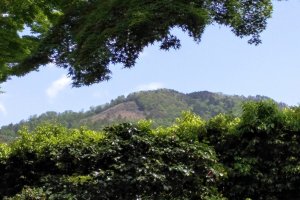Distance lends enchantment to the view. Kyoto seemed regal, serene, from the summit of Mount Daimonji, wrapped in a silence never heard below. Yet it was only about an hour away.
My enchanted view began at the Ginkakuji entrance. To the left, I saw Jodoin Temple, and of course I had to go in.
I didn’t see her at first. Sensing something looking at me, I turned round and there she was, enclosed in glass so I couldn’t see her too well, a life size wooden statue of an Imperial Consort. Now she prays for world peace and happiness.

Hachi Shrine was ahead. In I went again. The many lanterns strung around are for good luck and to guard the inhabitants of the area. I walked out and turned left onto the road leading from Ginkakuji. I passed signs of civilization, a vending machine, parked bicycles.
I came to a forked road with a red kami shrine. I kept right.
I crossed a bridge coming soon to a natural spring, and from then on it was steps uphill all the way. There was a patch or two which was just loose gravel and rock.
I didn’t feel the effort, I was immersed in fragrant forest air, bird song, the bubbling of a brook.
There was one bit to watch out for. A gap in the center of the trail divided the slope into two mini slippery clay ridges. I couldn't take photos - I was too busy looking for tree branches to hang on to for support!

Then came the Sennin-zuka juzo, an old war memorial. I kept them on my left as I followed the path that went around them.
Blue metal frames that used to be a tram car were my next checkpoint, and it was also goodbye to the easy part. It was actually just about 10-15 minutes of very steep slopes, and rough terrain, but it seemed to take forever.
I was gasping when I reached the first summit, at 226 meters. More gasping to see Kyoto at my feet! Then the famous stone blocks or fireplaces artfully placed around the summit and on the mountain slopes to form the Chinese character for “big”, 大.

The fireplaces are set aflame every August in a religious ceremony called Gozan no Okuribi, or “send-off fire”. The fires are lit at the exact time when the dearly departed must return to their world from ours, where they were visiting.
The mountain slopes were steep all the way down. Many people, mainly seniors, were braving the slopes and narrow steps to pick leaves and shrubs. I think it was for prayers.
I climbed to the next summit at 466 meters. I could see the built up areas creeping up the mountain sides. I could see it was true, though, that Kyoto, by law, couldn't have any buildings over 31 meters. This ruling has ensured its historic heritage.

I also tried - unsuccessfully - to see the grid pattern that I read about. Designed 1200 years ago, the Emperor had wanted it to keep evil spirits out. All I could see (or thought I saw but could have been hallucinating) was that the green areas, like strips, also seemed to form the Chinese letter Dai for “big.”
I returned the way I came.
A distance always shifts perspectives, like looking at things differently when you’re in a different country. On Daimonji, I could see possibilities to Kyoto, but also a “what might have been”.

































